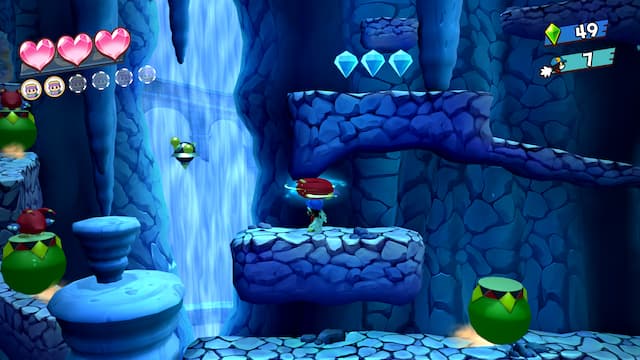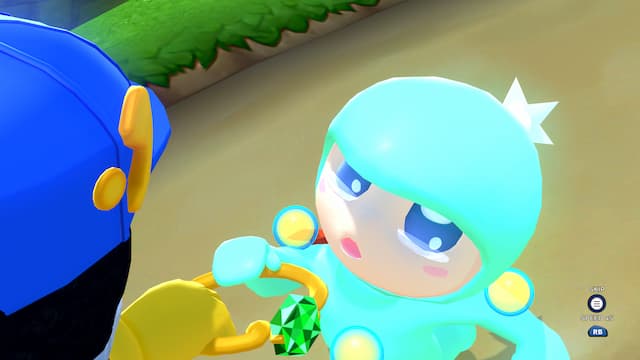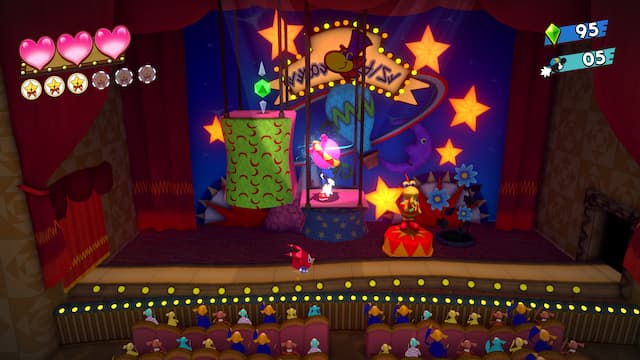Bandai Namco has reintroduced Klonoa for the first time in 14 years with Klonoa Phantasy Reverie Series. This remastered compilation of the first two mainline installments features largely overhauled assets and reworked music with the core gameplay untouched.
Despite some potentially controversial artistic changes to Klonoa 2, Klonoa Phantasy Reverie Series is an impressive remastered collection. As self-contained 2.5D platformers, they’re decent leisurely romps with an undeniable charm.
Klonoa Phantasy Reverie Series Review: Lighthearted Platforming Abounds
Klonoa has made its name on the mileage of its simplistic premise. Unlike many other platformers, there isn’t a traditional attack or even a stomp. Don’t dare to jump on top of enemies’ heads unless you want to take damage. Klonoa doesn’t even have access to a double jump under normal circumstances.
The moveset is dictated by the special ring Klonoa holds. Inhabited by a spirit, the ring can be used to grab enemies, and with a foe in your possession, you can either throw them at another or use them to initiate a double jump by stepping on them in mid-air.
These simple actions are often used in various combinations throughout the collection to complete light logic puzzles or test your platforming skills. One example is reaching an especially high platform with three hovering enemies at different levels of elevation. You need the dexterity to double jump using the previous foe while making sure you nab the next one to continue the chain without falling to the ground. Another example might include leaving a timebomb enemy near a switch, placing yourself in the proper position before the switch is activated.

Klonoa is the kind of game you want to play after an especially rough day. You’ll mostly breeze through the majority of the first installment – that is until the final world and last two major bosses, which feature drastic difficulty spikes. The lack of a consistent difficulty curve is its biggest failing, immediately transforming from an accessible platformer to a frustrating war of attrition.
Klonoa 2 is a direct extension of its predecessor, featuring the same gameplay systems with only minor additions. The sequel introduces a new creature type that changes color every time it absorbs a new enemy. These are used to shatter progress-gating crystals associated with a specific color. In some instances, their inclusion adds a light layer of puzzle-solving to otherwise straightforward scenarios. A few of these sections legitimately made me step back to analyze the situation in a way the first game never does.
Despite running with a refined version of a solid formula, Klonoa 2’s weak points prevent it from becoming a definitively superior game. Its narrative emphasis drags its pacing considerably. You’ll load from cutscene to cutscene only to walk back to a tile on the world map that initiates another cutscene with no playable sections in between. Its original developers placed too much stock in an unremarkable story that loses sight of its predecessor’s minimalism.
Klonoa 2 also suffers from unexpected repetition. Throughout, you’ll end up revisiting four previously completed levels. Enemy composition and goals differ, but the level design itself remains untouched. These also happen to be some of Klonoa 2’s longest levels, excursions that act as padding to bloat the runtime of a five-hour game.
Even with these caveats, Klonoa 2 gets bonus points for experimenting with its structure. Dreams are no longer confined to two levels, with a new dream essentially acting as a new world. It’s not afraid to throw you into one level in one biome before tossing you somewhere else. Klonoa 2 also features far more involved level design, with more inventive use of its environments. The circus levels and on-rails snowboarding sections stand out.
Reintroducing Classics to a New Audience

Klonoa: Door to Phantomile is a more successful visual translation than Klonoa 2. The original PS1 version utilizes a mix of 2D sprites, with 3D models making up the environment. Translating those 2D sprites into 3D models while remaining faithful is a herculean task, one which the 2008 Wii remake already proved to mixed results. In comparison to the Wii iteration, the conversion in Phantasy Reverie Series is a resounding success.
Character models are much more cartoony, eschewing the stylized realism of the 2008 remake. Textures resolve much more clearly, because of the higher native rendering resolution. More importantly, Klonoa Phantasy Reverie Series’ vibrancy aligns more closely with the PS1 look than the Wii’s more muted color palette and lighting effects. This version even drops the Wii’s criticized voiced acting in favor of the original Japanese-based gibberish-like language.
Klonoa 2: Lunatea’s Veil, however, is bound to upset some. From a purely technical standpoint, it is a categorical improvement over the PS2 entry in every respect. Character models, draw distances, geometric complexity, and texture quality are such a dramatic step up that this can be considered a remake.
However, it also adopts the same vibrant color scheme and lighting as Klonoa: Door to Phantomile, creating a disconnect. Klonoa 2 is a narratively darker game, with a more muted look to follow suit. Certain stages, such as Volk City, lack the dinginess of the PS2 original. If the occasional change like this doesn’t bother you, it is the definitive way to play Klonoa 2, doubly so for next-gen console owners. The new assets look great on modern displays running at native 4K at a locked 60 frames per second.
Klonoa Phantasy Reverie Series Review — The Bottom Line

Pros
- Dramatically enhanced visuals.
- Creative use of a simple concept.
- Charming music and character designs.
Cons
- Too much story and repetition in Klonoa 2.
- Random difficulty spike in Klonoa.
Klonoa Phantasy Reverie Series is a great choice for gamers that are especially attuned to 2D platformers. Minor controversies aside, the collection looks and feels great on modern platforms, with the Nintendo Switch’s inconsistent performance profile being the sole outlier.
The only thing holding the collection back is the quality of the games themselves. While cult hits in their own right, Klonoa games don’t exactly compete with the juggernauts of the platforming genre. However, that doesn’t mean this collection isn’t worth your time.
[Note: A copy of Klonoa Phantasy Reverie Series was purchased for this review.]







Published: Jul 9, 2022 09:24 pm